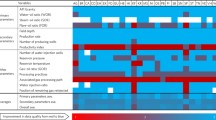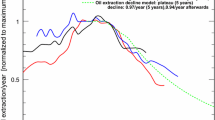Abstract
This study employs (1) a simple econometric model to generate a time series of drilling footage to the year 2040 and (2) learning models to estimate the oil reserve additions from that drilling, given scenarios of oil price and projected U.S. population. Reserve additions are estimated separately for the lower 48 states and Alaska regions by estimating separate drilling footage and learning models for each region. Generally, the estimates of potential supply from undiscovered oil fields and from extensions of known fields are more optimistic than recent estimates by others. For a $1989 price of about $20/barrel (bbl), which is similar to recent prices, the potential supply of oil is estimated to be approximately 60.7 billion bbl, with 95-percent confidence bounds of 54.3 and 67.1 billion bbl. For a price of $25.50/bbl, potential supply is estimated to be approximately 82 billion bbl, with 95-percent confidence bounds of 74.5 and 89.5 billion bbl. Although estimates of potential oil supply for the entire United States are more optimistic than other recent estimates, the part of that supply estimated to be forthcoming from Alaska is smaller than other recent estimates: 2.3 and 3.3 billion bbl for prices of about $20 and $25.50 per barrel, respectively. Thus, reserve additions from the lower 48 states through development drilling and through improved recovery and production technologies will become increasingly important to future U.S. oil supply.
Similar content being viewed by others
References
American Petroleum Institute, 1959, Petroleum facts and figures, Centennial edition: New York, American Petroleum Institute, 472 p.
—— 1991, Basic petroleum data book: Petroleum Industry Statistics, v. XI, no. 1: Washington, D.C., American Petroleum Institute.
Belkaoui, A., 1986, The learning curve—A management accounting tool: London, Quorum Books, 245 p.
Brantly, J.E., 1971, History of oil well drilling: Houston, Gulf Publishing Company, 1525 p.
Cargill, S.M., Root, D.H., and Bailey, E.H., 1980, Resource estimation from historical data—Mercury, a test case: Mathematical Geology, v. 12, no. 5, p. 489–522.
Dolton, G.L., Carlson, K.V., Charpentier, R.R., Coury, A.B., Crovelli, R.A., Frezon, S.E., Khan, A.S., Lister, J.H., McMullin, R.H., Pike, R.S., Powers, R.B., Scott, E.W., and Varnes, K.L., 1981, Estimates of undiscovered recoverable conventional resources of oil and gas in the United States: U.S. Geological Survey Circular 860, 87 p.
Fisher, F.M., 1964, Supply and costs in the U.S. petroleum industry—Two econometric studies: Baltimore, Resources for the Future, Inc., 177 p.
Fisher, W.L., 1987, Can the U.S. oil and gas resource base support sustained production? Science, v. 236, p. 1631–1636.
Halbouty, M.T., and Moody, J.D., 1980, World ultimate reserves of crude oil: Proceedings of the Tenth World Petroleum Congress, Bucharest, 1979, v. 2, p. 291–301.
Harris, D.P., 1989, Forecasting for mineral industries: Lecture notes for MnEc-665, Mineral Economics Program, Dept. of Mining and Geological Engineering, College of Engineering and Mines, University of Arizona, Tucson, Ariz., 415 p.
Harris, D.P., and Jcon, G.J., 1987, Improved methods for long-range forecasting of mineral demands: Research report to the Mining and Mineral Resources Research Institute, 161 p.
Harris, D.P., Miao, Ying Hong, Pan, Guocheng, and Wilson, Tetevi, 1992, Estimation of the potential supply of U.S. oil by life cycle and learning models: Nonrenewable Resources, v. 1, p. 239–252.
Hubbert, M.K., 1974, U.S. energy resources, a review as of 1972. Part I. Background paper prepared at the request of Henry A. Jackson, Chairman, Committee on Interior and Insular Affairs, U.S. Senate, 93rd Congress, 2nd session, Committee Print Serial No. 93-40 (92–75): Washington, D.C., U.S. Government Printing Office, 267 p.
Jeon, Gyoo Jeong, 1989, Innovative methods for long-run mineral forecasting: Ph.D. dissertation, Mineral Economics Program, Dept. of Mining and Geological Engineering, University of Arizona, Tucson, Ariz., 229 p.
Joint publication of Amerian Gas Association, American Petroleum Institute, Canadian Petroleum Association, 1973, Reserves of crude oil, natural gas liquids and natural gas in the U.S. and Canada and U.S. productive capacity, v. 27, Arlington, Va., AGA, 252 p.
Lewis, C.J., 1986, Are our oil and gas resource assessments realistic?in Dudley, D.R., ed., Oil and gas assessment—Methods and applications: AAPG Studies in Geology 21, p. 195–202.
Mast, R.F., Dolton, G.L., Crovelli, R.A., Root, D.H., Attanasi, E.D., Martin, P.E., Cooke, L.W., Carpenter, G.B., Pecora, W.C., and Rose, M.B., 1989, Estimates of undiscovered conventional oil and gas resources in the United States—A part of the nations energy endowment: U.S. Geological Survey and Minerals Management Service, Washington, D.C., U.S. Government Printing Office.
Nehring, R., with van Driest, E.R.,II, 1981, The discovery of significant oil and gas fields in the United States: The Rand Publication Series R-2654/1-USGS/DOE, 2 v., 236 p. and 477 p. (appendix).
Pierson, G., 1981, Learning curves make productivity gains predictable: Engineering and Mining Journal, v. 183, p. 56–64.
Root, D.H., 1980, Historical growth of estimates of oil and gas field size, paper presented at the Symposium on Oil and Gas Supply Modeling, June 19, 1980: Washington, D.C., Dept. of Energy and National Bureau of Standards.
Rozendal, R.A., 1986, Conventional US oil and gas remaining to be discovered—Estimates and methodology used by Shell Oil Company,in Rice, D.D., ed., Oil and gas assessment—Methods and applications. AAPG Studies in Geology 21, p. 151–158.
Suslick, S.B., and Harris, D.P., 1990, Long-range metal consumption forecasts using innovative methods—The case of aluminum in Brazil to the year 2000: Resources Policy, v. 16, no. 3, p. 184–199.
U.S. Bureau of the Census, 1989, Current population reports—Population estimates and projections: series p-25, no. 1018, 171 p.
U.S. Bureau of Labor Statistics, 1983, Trends in multifactor productivity, 1948–1981: Bulletin 2178, 80 p.
Author information
Authors and Affiliations
Rights and permissions
About this article
Cite this article
Harris, D.P., Wilson, T. Econometric and learning curve estimation of U.S. potential oil supply. Nat Resour Res 1, 323–347 (1992). https://doi.org/10.1007/BF01782696
Received:
Revised:
Accepted:
Issue Date:
DOI: https://doi.org/10.1007/BF01782696




